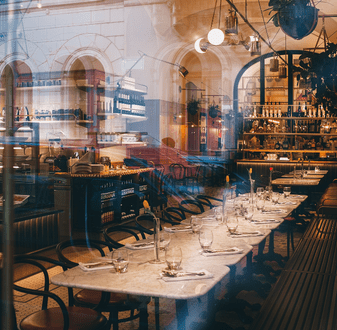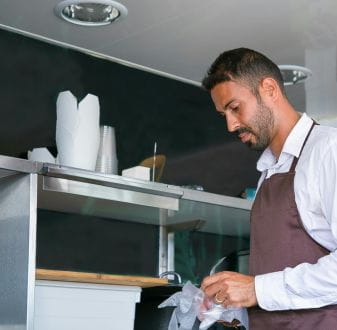Let’s take a look at the top 5 hospitality design trends shaping the industry right now, and how operators can jump on board to attract new customers.
1. Green design is now a priority
According to research by the Sustainable Hospitality Alliance, the hotel industry needs to reduce its carbon emissions by 66% per room by 2030 and by 90% per room by 2050 in order to keep carbon emissions at a sustainable level. Green design is a top priority right now for operators who have promised to meet net-zero commitments and want to draw in increasingly environmentally conscious customers.Green design trends in hospitality today mean moving beyond the banning of single-use plastics across your operation. This year it will also be about the triple bottom line, low-impact architectural design, serious climate commitments and making an impact across the whole supply chain. Customers want to know where everything from food to furniture comes from, what carbon offsetting or philanthropic activities your business is engaged in, and what you’re doing to manage waste and mitigate any negative output.
The question is: in an industry that has traditionally been pretty unsustainable, how can sustainable design help your business to become a real, positive agent of change?
It’s time to minimise. Green design for hospitality operators in 2023 is all about stripping things back, cutting out carbon miles and going local. Hotels are removing unnecessary waste items from rooms, taking complicated unseasonal dishes off the menu, and focusing on quality over quantity.
Guests today want their hospitality to be local: local organic produce in the restaurant, local artisans designing the furnishings, locally produced art objects and locally themed spaces, local staff showing them local attractions, and the use of natural construction materials like stone and wood that are unique and local to the area.
2. Wellness activities and products are at the front and centre
Traditionally relegated to hidden basement areas in most hotels, fitness and day spa facilities are taking front and centre stage right now as the wellness sector continues its unprecedented post-pandemic boom in hospitality. Wellness has become a big selling point for hospitality operators who are keen to attract a share of this growing market.The wellness trend is reshaping the aesthetics, focus and functionality of architectural and interior design in hotels, as well as activities programming and the design of wellness products and packages.
Interior designers have been busy bringing wellness facilities out of the basement and placing them at the centre of hotel properties in locations with the best views and access to indoor-outdoor green spaces. Fitness equipment has found its way into private rooms, and wellness activities are now offered outside the hotel with guides taking guests into nature.
The scope of wellness products and activities on offer is also dramatically expanding from standard massage, mindfulness, yoga and meditation packages. Trained nutritionists and wellness practitioners now guide a guest's whole-stay mindfulness experience through new personalised consulting programs offered by hotel brands such as Marriott and Four Seasons.
3. More greenery and gardens
After a few years of pandemic lockdowns, consumers are nostalgic for simpler times and more contact with nature. Coupled with the sustainable eating trend towards local, organic produce and what we have in hospitality; 2023 is a big year for gardens of all shapes and sizes.Decorative herb gardens and organic kitchen gardens supplying produce for the restaurant on-site are trending in a big way. Urban restaurants and hotels that don’t have space for their own gardens are outsourcing local organic growing to local farmers and they are telling customers about those relationships.
Indoor and outdoor green spaces are key for hotel interior design in 2023. Gardens that come inside via flexible indoor-outdoor spaces or big windows, Gardens showcasing native plants and attracting local birds, green walls, green spaces for meditation and yoga, and greenery in the restaurant and communal spaces are all hitting the mark. Potted plants in rooms are more work for staff to keep alive but they are popular with guests and add to the home-away-from-home cosy appeal for long-term guests.
4. Designing spaces for digital nomads
The latest data from 2022 shows that there are now approximately 35 million digital nomads working worldwide. Between 2019 and 2020 alone, estimates show growth in the number of digital nomads by a huge 49% for that year.
Remote and digital workers are still on the rise in 2023, replacing traditional short-term business and conference travellers, and that continues to have an impact on hospitality design. With the use of strategic design, hospitality operators can cater to this growing market of digital natives, encourage them to stay for longer and to spend more during their stay.
Simple design upgrades are effective for hotel operators to better cater to the growing digital nomad market:
- Separate work and sleeping areas in rooms with the desk placed away from the bed
- More wardrobe space
- Flexible suites and adjoining rooms that can be adapted for use as a lounge or private office, private fitness room, lounge or child’s room
- Offering comfortable coworking spaces and flexible workspaces with internet and facilities
- Upgrading lounge, cafe, lobby and communal spaces to provide comfortable leisure areas for digital workers during downtime
5. Comfortable luxury
Staycations and long-term working holidays are on the rise in a big way, and that’s expected to continue into 2023. According to recent data from the vacation rental management platform Hostaway, trips longer than 28 days have increased by 106% since 2019.
With the rise of the staycation, many guests are now looking for hotel, dining and accommodation experiences that offer all the comforts of home but with more style and luxury. They want to spread out across the different hotel spaces, connect with others in communal areas and feel at home across the whole property. Hospitality operators are investing in plush furniture settings, flexible communal spaces, and rooms set up with homey conveniences.
In 2023, staycation guests will be looking for comfortably luxurious hospitality designs, such as:
- Gorgeous and functional lobbies serve as comfortable communal spaces, complete with libraries, study corners, group dining tables and relaxation areas.
- Stylish sofas and comfy armchairs to curl up in just like at home but with a luxurious twist: think pastel wool and linen, rich velvet tones, warm wooden features and tactile knitted textiles.
- Flexible spaces that offer different degrees of privacy, using attractive screens and modular dividers.
- Rooms with home-away-from-home cosy interior design and conveniences like kitchenettes, Netflix, crockery, extra blankets and stylish but comfortable hang-out areas.





